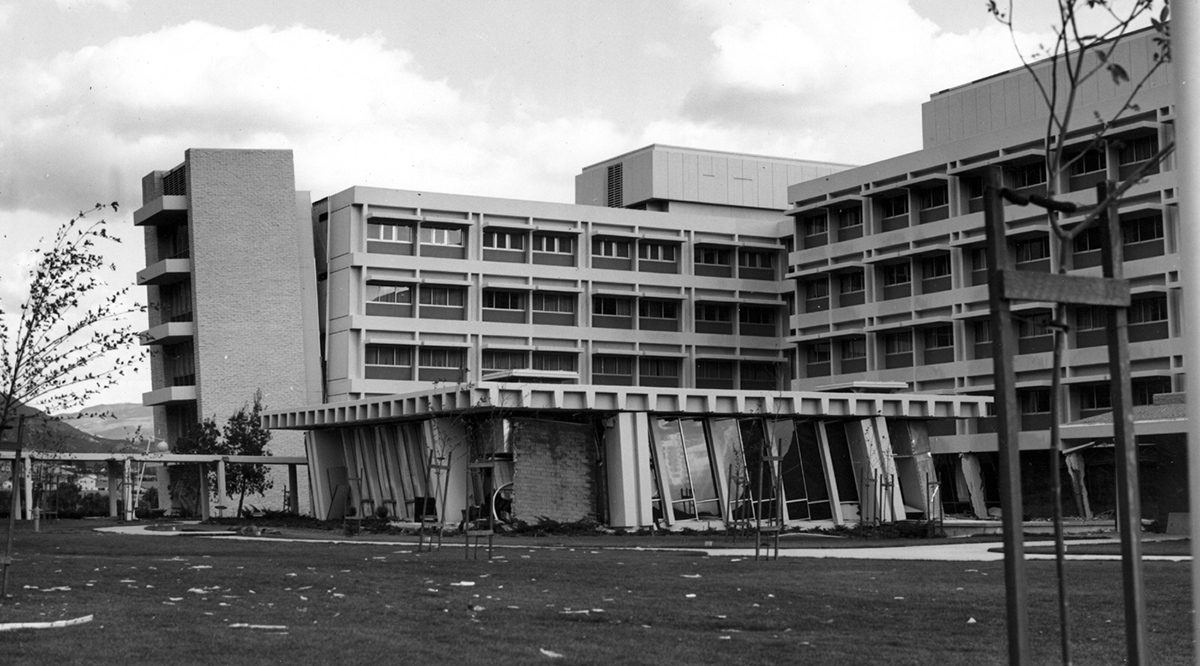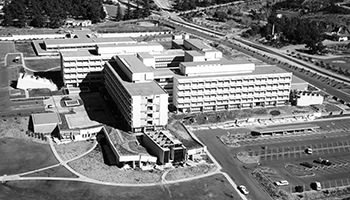In July 2019, a 6.4 magnitude earthquake struck a sparsely populated region in Southern California. For teaching hospitals racing to meet seismic safety regulations in 2020 and 2030, it was a stark reminder that it’s not a matter of if “The Big One” will strike, but when.

When the Sylmar-San Fernando earthquake struck Southern California in 1971, 64 people were killed and more than 2,500 injured. One of the hardest-hit buildings was the just-completed San Fernando Veterans Administration Hospital, whose unreinforced concrete wings collapsed, killing at least 44 people. Twenty-three years later, the Northridge quake injured more than 7,000 people and crippled hospitals throughout the Los Angeles area. Eleven hospitals in the region were damaged. Nine had to be evacuated. All told, the quake caused $3 billion in damage to the region’s hospitals.
After each of these devastating quakes, state officials issued stricter seismic safety standards for California hospitals. The first requirements — building codes designed to ensure that hospital buildings will withstand a major earthquake without collapsing — go into effect between 2020 and 2022. “With a few exceptions, virtually all of our hospitals are on track to meet that deadline,” says Jan Emerson-Shea, chief spokesperson for the California Hospital Association (CHA). In 2030, even tougher state standards take effect — requirements designed to ensure that hospitals not only remain standing but can also go on operating.
Being able to ride out a major quake and remain operational doesn’t come cheap. The regulations set to go into effect in 2030 are unfunded, which means the legislation does not specify where the money will come from to meet the stringent requirements. In fact, it represents the largest unfunded mandate ever passed by the state, with much of the burden falling on hospitals and health care systems. The CHA estimates that California’s hospitals have already spent billions of dollars to retrofit existing buildings or construct new ones.
The next phase could prove even costlier. A new peer-reviewed report from the RAND Corporation, funded by the CHA and released in April 2019, estimated that the cost of meeting the 2030 requirements will run between $34 billion and $143 billion. According to the analysis, which included the state’s 418 general acute-care hospitals, 34% of California hospitals are already experiencing some level of financial distress. Complying with the 2030 mandate could increase that number to 50%.
But with predictions that a major quake is highly likely to hit densely populated urban areas within the next 30 years, medical schools and teaching hospitals across the nation’s most populous state continue to prepare to meet the challenge of seismic safety.
Built to ride out “The Big One”
The sprawling medical center of the University of California, Los Angeles (UCLA), near one of the state’s most dangerous faults, is no stranger to earthquakes. During the 1994 Northridge quake, the old hospital on its campus sustained significant structural damage. In the aftermath, planning began to replace the building with a brand-new facility — one of the first in California to meet stricter seismic safety standards. The construction included specially shaped and sized steel beams designed to enable the building to withstand a greater than 8.0 magnitude quake and remain fully operational for up to 72 hours after a quake even if water, electricity, and other services are cut off. The new hospital opened its doors in 2008 and is now part of the Ronald Reagan UCLA Medical Center.
Funds for the construction came from a variety of sources. The Federal Emergency Management Agency contributed $432 million in earthquake relief. The State of California provided $44 million. Private donors contributed nearly $300 million. The rest came from hospital financing and bonds.

Other major medical centers across the state — from Stanford Medicine in Palo Alto, California, to the University of California, San Francisco, to Loma Linda University in San Bernardino, California — are also building brand new hospitals designed to meet the most stringent seismic codes.
Stanford Medicine’s new hospital is set to open its doors this fall — an 824,000 square foot, 368-bed facility that represents today’s state-of-the-art in seismic design. Buried 35 feet below ground level are 206 base isolators — huge steel and teflon “coasters” that serve as footings for the building’s structural columns. The isolators are designed to be able to move from side to side by as much as 3 feet in any direction during an earthquake, allowing the building to remain standing even after a massive 8.0 magnitude earthquake.
But that’s just part of the building’s protective armature. The pipes and wires that carry water, electricity, communications links, and sewage have also been designed with enough flexibility to be able to move without breaking during a major quake. Even the building’s parking structure has been designed with a disaster in mind: it can be converted into extra triage space in the event of a major surge of injured patients. “That’s really important, because the hospital is the only trauma 1 facility between San Francisco and San Jose,” says Bert Hurlbut, vice president of new hospital construction at Stanford Health Care. “If there’s a major earthquake in this region, this is where many of the injured will be taken.”
The price tag of the new building, which meets and exceeds the mandated seismic requirements for 2030: a staggering $2 billion.
University of California (UC), Davis, Health has also budgeted approximately $2 billion over the next 10 years to comply with the new seismic safety mandate. A new hospital tower and emergency surgical services pavilion have already opened, along with the Children’s Surgery Center. The oldest part of the medical campus, the North/South Wing, can’t be cost-effectively retrofitted. Once its departments and services have been relocated to buildings that meet the new seismic codes, a process that is currently underway, it will be demolished.
To the south, Loma Linda University Health is nearing completion of a new 276-bed adult hospital and 100-bed children’s hospital tower. Like Stanford’s new hospital, both structures are built on base isolators designed to allow the building to ride out a major earthquake. The base isolation system, first developed in Japan, has proven its ability to withstand major earthquakes. After the massive Fukushima earthquake in 2011, buildings on base isolators suffered very little damage compared to buildings constructed with older seismic methods.
“The point isn’t to scare people into being prepared. It’s to give people the confidence and knowledge they need to respond safely when the next earthquake happens.”
Marjorie Smallwood
UCSF Health
Along with ensuring the integrity of hospital buildings, the state’s academic medical campuses are also developing plans to make sure they can continue to operate even if electricity and water are disrupted. Cedars-Sinai in Southern California, for example, is in the process of completing several major infrastructure upgrades. “The first has been a groundwater project that utilizes natural groundwater to cool the hospital rather than relying on city water,” explains Zeke Triana, vice president of facilities planning, design, and construction. “We are currently completing an electrical reliability project that will allow us to transfer 100 percent of the hospital electrical load onto the emergency generators for more than 72 hours.”
Small hospitals face a bigger challenge
Large institutions like the UC medical systems and metropolitan hospitals can draw on support from both public and private sources for major projects like these. In 2014, for example, Loma Linda University Health launched its building campaign with the announcement of a $100 million gift and has raised $200 million thus far.
The state’s smaller hospitals aren’t so fortunate. Unable to cover the costs of new construction or seismic retrofit, some have been forced to close. The fate of others remains uncertain. When Long Beach Community Hospital, also in Southern California, announced it would be forced to close, community members rallied to save the facility. A new operator has been named and the hospital has been granted an extension on the seismic deadline while construction plans are developed. “We’ve managed to clear some major hurdles,” said Matthew Faulkner, executive director of the Community Hospital Long Beach Foundation. “But we still have some heavy lifting to do.”
According to the RAND report, the hospitals under the greatest financial stress are public health care district hospitals, independent private hospitals, critical access hospitals that serve rural areas, and facilities with a large share of Medi-Cal patients.
The next big one
California had been in the midst of what seismologists have dubbed an earthquake drought — which is classified as an unusually long stretch without a major shake-up. In July 2019, that changed, when a 6.4 temblor, followed by an even bigger 7.1 aftershock, jolted the sparsely populated Mohave Desert region in the south-central part of the state — a fresh reminder of just how vulnerable California and its medical infrastructure are. Parts of Ridgecrest Regional Hospital, near the epicenter, had to be evacuated. Four days after the quake, the acute care unit remained closed, although all sections of the hospital were expected to return to normal operation after inspections were completed.
Far more disastrous earthquakes are a certainty. According to a U.S. Geological Society report published in 2017, there’s a 72% chance of one or more major 6.7 quakes on the Hayward fault in the San Francisco Bay area — one of the most densely populated areas of the state — by 2043. A quake of that magnitude would result in an estimated 800 deaths and 18,000 people injured, many requiring emergency care.
Today, the state’s hospitals are better prepared than ever to ride out a devastating quake. “But we can’t become complacent,” says Marjorie Smallwood, director of emergency management at UCSF Health. Like most medical centers, UCSF conducts an annual hazard vulnerability assessment and reviews its preparedness protocols. The sprawling facility also participates in the Great ShakeOut, a day devoted to earthquake drills and information. “The point isn’t to scare people into being prepared,” she explains. “It’s to give people the confidence and knowledge they need to respond safely when the next earthquake happens.”